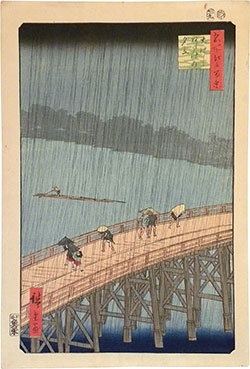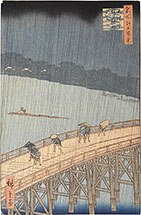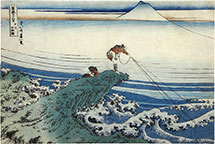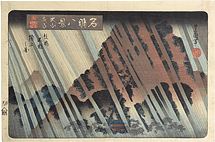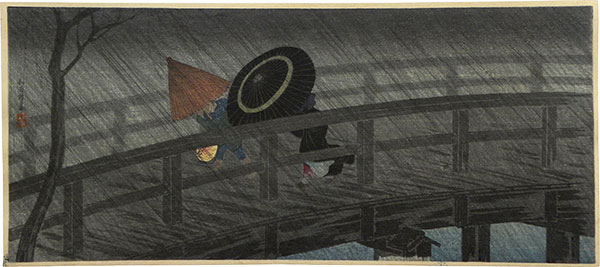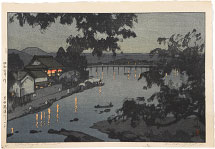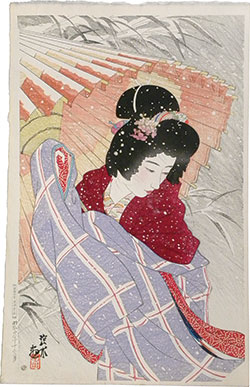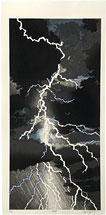
Dark & Stormy:
Evocative Images for Uncertain Times
New York
September 11 - 19, 2014
11 am - 5 pm
otherwise through October 31st by appointment
view the online exhibition...
index of the exhibition...
Scholten Japanese Art is pleased to announce our upcoming gallery exhibition, Dark & Stormy: Evocative Images for Uncertain Times, an exhibition primarily of nocturnal landscape woodblock prints from the 19th and 20th centuries which depict atmospheric evening views, inclement weather, or both. The theme of 'Dark & Stormy' was initially conceived of during a particularly blustery spring in New York with the intention of exploring the enduring appeal of moody, nocturnal subjects. However, the dark theme took on greater meaning as this year has progressed with a succession of ominous worldwide developments that have added to an atmosphere of anxiety in these 'Uncertain Times.'
Perhaps the popularity of nighttime subjects is driven by an inclination to seek in art that which resonates— while sunny views and blue skies may offer hope and inspiration, dark views and rough seas are a counterpoint to those inspirational vistas. One of the most iconic images included in the show will be an excellent impression of Sudden Shower at Atake (also known as Ohashi Bridge), 1857, by Utagawa Hiroshige (1797-1858) from his preeminent series, One Hundred Famous Views of Edo. Widely considered one of the most important Japanese woodblock print designs, the composition evidently spoke to Vincent Van Gogh (1853-1890) who copied it in oils in 1888. In addition to this near-pristine impression, the gallery will also exhibit a very rare earlier state of the same print, commonly known as the 'Two Boats Ohashi'- in reference to the silhouettes of boats at the far right which were removed when the grey block of the distant shore was replaced very early on in the production of the print. The earlier 'Two Boats' impression is additionally differentiated by more dramatic dark storm clouds streaking down from the sky.
Another famous image included in the exhibition is by Hiroshige's contemporary and fellow landscape artist master, Katsushika Hokusai (1760-1849). Kajikazawa in Kai Province from the series Thirty-Six Views of Mt. Fuji, ca. 1831, depicts a fisherman standing on a rock promontory which juts sharply out over tumultuous seas. The precarious figure holds taut fishing lines which extend down into the frothing waves while a small child sits behind him crouched over a basket. The churning waves crash menacingly against the rock in the lower third of the composition, while bands of horizontal waves and clouds recede into the middle distance and the peak of Mt. Fuji emerges from the mist in the far distance.
Powerful storms offer the opportunity for dynamic compositions in a variety of ways. The dramatic diagonal lines of Hiroshige's Ohashi Bridge are relatively tame in comparison with the wide distorting bands of blue and grey which Utagawa Toyokuni II (1777-1835) used in his print, Night Rain at Oyama from his series, Eight Celebrated Views, ca. 1830s, in which a heavy rainfall striates Mount Oyama ('Great Mountain') located in Kanagawa. The fury of the storm envelopes the mountain in sheets of rain while a temple in the foreground is dwarfed by both the looming mountain and the darkened sky. In spite of the tempest, undaunted pilgrims climb the steep stairs which ascend the mountain to an ancient sacred site for both Shinto and Buddhist worship, including fittingly, the Shinto god of rain.
In comparison to the tiny figures overwhelmed by the storm at the summit in Toyokuni II's composition, Rain on Izumi Bridge, a woodblock print by Takahashi Hiroaki (Shotei, 1871-1945) focuses on a closer view of a woman and her attendant caught in a downpour as they hurry across a bridge. Framed by a narrow horizontal format which emphasizes the slight curve of the bridge, Shotei uses a very dark palette which is broken only by the red-orange glow from the attendant's paper lantern.
Evening on the Chikugo River, Hita, 1927 a woodblock print by Hiroshi Yoshida (1876-1950) employs a similar technique, the atmospheric view of the Chikugo River from an elevated vantage framed at the top and left by roughly defined foliage. The dark greyish blue-green palette is pierced by the bright glow of lit windows of a teahouse on the shore, and wavy vertical lines of light reflecting on the water.
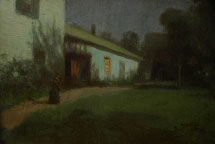
An earlier oil on board painting by the same artist, Tyringham (Massachusetts) from 1905 was painted during the artist's second trip to America— a period during which he produced several nocturnes which suggest an influence by the work of James McNeill Whistler (1834-1903), who had died the previous year and with whom he shared a patron, Charles Lang Freer (1854-1919). The painting depicts the figure of a woman obscured by shadows standing on a pathway beside a building which appears to be a residence. The soft shadows cast across the pale walls suggest a moonlit evening. Here also the darkness is broken by light emanating from within the structure which draws our attention towards the warm glow but also emphasizes the solitary figure in the foreground who is shut out from the comforts within.
Another print from the 20th century by the artist Ito Shinsui (1898-1972), Snowstorm, from The Second Series of Modern Beauties, depicts a dynamic image of a beauty wearing a deep red-colored kimono struggling to hold her umbrella open against the biting wind of a swirling snowstorm. The entire composition is defined by the angle of the umbrella echoed by the position of her head in relation to her body, the lavender plaid over-robe billowing around her, and the snow-covered bamboo leaves— all strong diagonals reinforcing the direction of the wind.
Most of the works included in the exhibition will be woodblock prints (although there will be at least one painting, as described above), and will include works by Katsushika Hokusai (1760-1849), Utagawa Hiroshige (1797-1858), Utagawa Toyokuni II (1777-1835), Takahashi Hiroaki (Shotei, 1871-1945), Hiroshi Yoshida (1876-1950), Ito Shinsui (1898-1972), Kawase Hasui (1883-1957), Kasamatsu Shiro (1898-1991), Charles W. Bartlett (1860-1940), Paul Binnie (b. 1967) and others. There will be approximately 40 works on view at the gallery and in the online exhibition.
Scholten Japanese Art is located at 145 West 58th Street, Suite 6D, between 6th and 7th Avenues. For the duration of the exhibition, September 11 - 19, the gallery will have general open hours (no appointments needed), 11 - 5 pm.
Exhibition Dates
September 11 - 19, 11 - 5 pm
otherwise through October 31st by appointment
